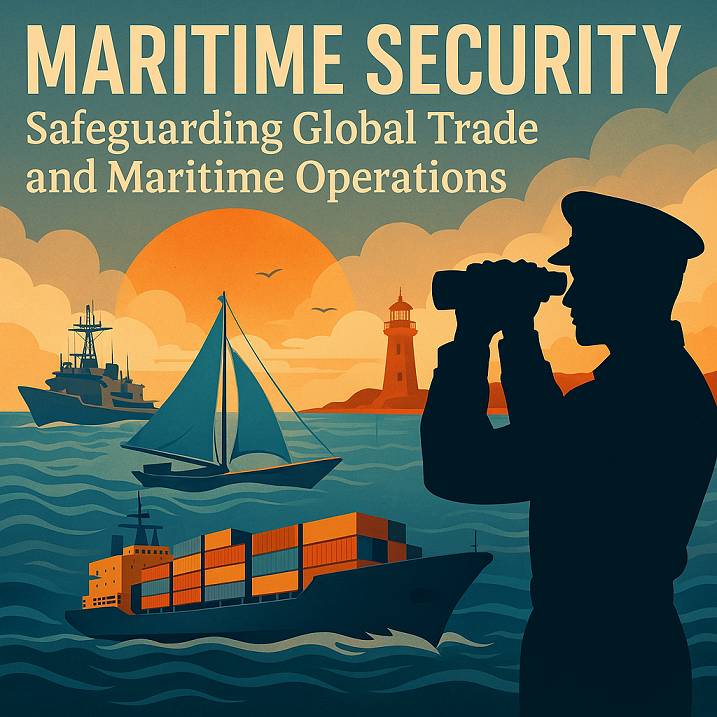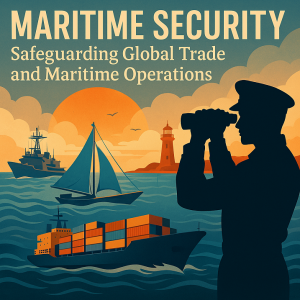Explore the critical importance of maritime security, from piracy prevention to cyber threats and port protection. This comprehensive guide is tailored for maritime students, cadets, ship officers, and industry professionals.
Who Keeps the Seas Safe?
Every day, over 50,000 merchant ships sail the oceans, transporting 90% of global goods. But behind this seamless movement lies a constant battle to protect these vessels, ports, and seafarers from piracy, terrorism, cyberattacks, and illegal activities. This is the realm of maritime security—an essential but often overlooked pillar of the maritime industry.
Whether you’re a maritime student, cadet, ship officer, or part of a shipping company, understanding maritime security is critical in today’s interconnected and unpredictable world.
What Is Maritime Security?
Maritime security refers to the protective measures and policies designed to ensure the safety of ships, ports, seafarers, cargo, and coastal infrastructure from threats such as piracy, smuggling, terrorism, cyberattacks, and environmental crimes.
🔒 Key Objectives of Maritime Security:
-
Prevent unlawful acts at sea (e.g., piracy, armed robbery)
-
Secure maritime trade routes and chokepoints
-
Protect ports and terminals
-
Mitigate cyber risks on maritime systems
-
Respond to maritime terrorism and environmental sabotage
⚓ The goal of maritime security is to protect freedom of navigation and support safe, uninterrupted global maritime trade.
Key Components of Maritime Security
🏴☠️ 1. Piracy and Armed Robbery Prevention
-
Common hotspots: Gulf of Guinea, Strait of Malacca, Somali Coast
-
Countermeasures include:
-
Naval escorts and patrols
-
Best Management Practices (BMP) guidelines
-
Shipboard armed guards and Citadel (safe room) design
-
🧯 2. Port and Coastal Security
-
Implementation of the International Ship and Port Facility Security (ISPS) Code
-
Includes access control, surveillance systems, fencing, and patrols
🛰️ 3. Maritime Domain Awareness (MDA)
-
Using satellite tracking, AIS, drones, and radar to monitor vessel movements and threats in real time
💻 4. Cybersecurity at Sea
-
Protection of onboard systems such as ECDIS, GMDSS, and engine controls from hacking
-
IMO’s 2021 cyber risk management mandate under the ISM Code
🌍 5. Counterterrorism and Illicit Trafficking
-
Interdiction of weapons, drugs, and human trafficking via sea routes
-
Collaboration among coast guards, navies, customs, and INTERPOL
International Regulations and Frameworks
🔹 ISPS Code
-
Mandated by the IMO under the SOLAS Convention post-9/11
-
Requires port facilities and ships to have security plans, designated officers, and incident protocols
🔹 UNCLOS (United Nations Convention on the Law of the Sea)
-
Defines the legal framework for actions against piracy and armed robbery
🔹 Maritime Labour Convention (MLC) 2006
-
Addresses seafarer welfare during high-risk voyages and detentions due to security events
🔹 Regional Agreements
-
ReCAAP (Asia), SHADE (Horn of Africa), GoG-MCF (Gulf of Guinea), and others support cooperative patrols and intelligence sharing
Real-World Applications & Case Studies
🛳️ Case 1: Piracy Off the Coast of Somalia
-
In 2009–2011, attacks spiked with over 200 piracy incidents annually
-
The launch of NATO and EU naval operations helped deter pirate activities and reduce incidents dramatically
🛰️ Case 2: GPS Jamming in the Strait of Hormuz
-
Several commercial ships reported GPS signal interference attributed to geopolitical tension
-
Highlighted the need for redundant navigation systems and cyber risk awareness
⚠️ Case 3: Port of Antwerp Cyberattack
-
Hackers manipulated container movement systems to facilitate drug smuggling
-
Resulted in ports worldwide adopting stricter digital security protocols
Importance of Maritime Security for Stakeholders
👨🎓 For Students & Cadets:
-
Gain awareness of real-world risks at sea
-
Learn best practices in personal safety and security protocols
🧭 For Ship Officers:
-
Conduct security drills and implement the ship’s security plan
-
Coordinate with Company and Ship Security Officers (CSO, SSO)
🏢 For Shipping Companies:
-
Ensure compliance with ISPS, cybersecurity, and crew safety regulations
-
Invest in ship tracking, secure communications, and anti-piracy measures
Emerging Trends in Maritime Security
🔐 1. Integrated Cyber-Physical Security
-
Merging of physical access control with cybersecurity layers for ports and ships
🤖 2. Use of AI and Drones
-
AI for predictive threat detection
-
Drones for patrolling offshore infrastructure and detecting unauthorized vessels
🌊 3. Climate-Linked Security Risks
-
Climate change increasing illegal fishing, migration, and territorial disputes in vulnerable coastal regions
🤝 4. Public-Private Collaboration
-
Greater emphasis on cooperation between navies, shipping firms, tech providers, and intelligence agencies
FAQs: People Also Ask
What is maritime security in simple terms?
It is the protection of ships, ports, cargo, and personnel from threats such as piracy, terrorism, smuggling, and cyberattacks.
What is the ISPS Code?
The ISPS Code (International Ship and Port Facility Security Code) sets mandatory security requirements for ships and port facilities to prevent security incidents.
What are the biggest threats in maritime security today?
Piracy, cyberattacks, illicit trafficking, GPS jamming, terrorism, and geopolitical tensions in critical sea lanes.
What does a maritime security officer do?
They implement and oversee the ship’s or port’s security plan, conduct inspections, respond to incidents, and liaise with authorities.
Conclusion: Safe Seas, Strong Trade
In a globalized world where maritime transport is the backbone of commerce, maritime security is more than just an operational concern—it’s a strategic necessity. For students, cadets, and industry professionals, staying updated on maritime security challenges and protocols is essential to ensuring safer voyages and sustainable shipping.
⚓ Next Steps:


